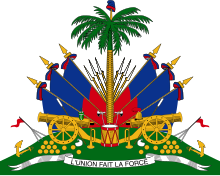Education in Haiti
 |
|
| Minister of National Education & Professional Training | Nesmy Manigat |
|---|---|
| Primary languages | French, Creole |
| Total | 60.7% (est. 2015) |
| Male | 64.3% |
| Female | 57.3% |
| Primary | 88% |
The Haitian Educational System yields the lowest total rate in formal education in the Western Hemisphere. Haiti's literacy rate of about 61% (64.3% for males and 57.3% for females) is below the 90% average literacy rate for Latin American and Caribbean countries. The country faces shortages in educational supplies and qualified teachers. The rural population is less educated than the urban. The 2010 Haiti earthquake exacerbated the already constrained parameters on Haiti's educational system by destroying infrastructure and displacing 50-90% of the students, depending on locale.
International private schools (run by Canada, France, or the United States) and church-run schools educate 90% of students. Haiti has 15,200 primary schools, of which 90% are non-public and managed by communities, religious organizations or NGOs. The enrollment rate for primary school is 88%.Secondary schools enroll 20% of eligible-age children. Higher education is provided by universities and other public and private institutions.
The educational sector is under the responsibility of the Ministre de l'Éducation Nationale et de la Formation Professionnelle (MENFP). The Ministry provides very little funds to support public education. As a result, the private sector has become a substitute for governmental public investment in education as opposed to an addition. The Ministry is limited in its ability to improve the quality of education in Haiti.
Despite the deficiencies of the Haitian education sector, some Haitian leaders have attempted to make improving education a national goal. The country has attempted three major reform efforts, with a new one in progress as a response to the earthquake.
"African slaves were worked so hard by French plantation owners that half died within a few years; it was cheaper to import new slaves than to improve working conditions enough to increase survival. This attitude allowed no time or resources for the education of the enslaved. Children of slaveholders were tutored in the early grades at home and then sent to France for further study. There were few schools in Sante Domingue. At the time of independence, years of war had demolished most infrastructure including any educational facilities.
...
Wikipedia
